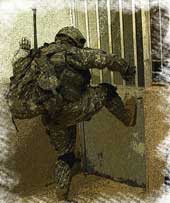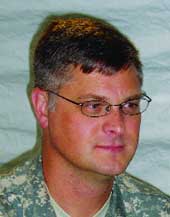Tools for tomorrow's warriors

New technologies will send soldiers to war with more tools for logistics,communications and safety.
In their quest to bring security to Baghdad and other areas of Iraq, U.S. troops are forced to kick in a lot of doors.Wouldn't it be nice if soldiers knew what was waiting for them on the other side of those doors? Are there people there? How many? Where are they?Thanks to new technology being developed by CACI International Inc., the ability to practically see through walls might be a reality in the very near future. Sense Through the Wall technology ? sort of like night vision for looking through masonry, wood and steel ? is an example of technology military leaders are seeking today.The technologies future warriors will carry into combat cover a wide spectrum but are primarily focused on conflicts the United States is in today and likely will face in the future.Technology companies and systems integrators are working with their military customers to solve pressing problems like avoiding improvised explosive device attacks, making covert operations safer, ensuring field medical units have the right supplies and more.Some technologies are just months away from deployment, but others still have development hurdles to overcome. The following systems are good examples of the kinds of challenges warfighters are facing and how technology companies are helping meet them.The threat of roadside bombs, or IEDs, is all too familiar to troops patrolling in and around Baghdad. IEDs cause more casualties among U.S. soldiers than any other attacks in Iraq, according to Pentagon data.What if there were a way to deliver real-time intelligence to patrols before they hit the streets?A new program being developed at the Joint Forces Command aims to do just that.The Knowledge and Information Fusion Exchange, or Knife, program is a series of databases that provide the warfighter with lessons learned and serves as an information exchange program, said Ken Knueven, federal programs manager at Microsoft Corp.A unit planning a ground excursion could check Knife to learn about the route."The Web portal would show what [IED] activity has taken place on that route," Knueven said. "And during the excursion, if they identify something suspicious, they can have a real-time collaboration with the source information in the portal or by talking with the subject-matter experts directly."The system is accessible via the Web, and it will be populated by existing databases and new information from content management software, such as SharePoint.The Knife program is being improved under a partnership between Microsoft and Joint Forces Command, which Knueven said is a great avenue to working with military customers."The military is open to these partnerships," he said. "We welcome the opportunity to get closer to the Joint Forces Command to understand from the warfighter level what the polices, procedures and processes really are."The military has used helicopters since World War II, and they continue to be essential in today's conflicts.Selecting routes and landing locations that keep helicopters out of earshot of the enemy has always been a challenge. Landing too far away means troops are exposed to more risk as they hike to a target. Land too close, and the enemy may hear the aircraft."The question is always, 'How close can we get?'" said Greg Warneford, lead systems engineer for General Dynamics Corp.'s Decision Support Systems division. "And nobody has ever been able to answer that in the past."A new computer modeling system now gives commanders the information they need to determine exactly how close they can get to a target.The atmospheric acoustics system displays an animated footprint of the sound given off by a helicopter. The model takes into account factors such as altitude, temperature and humidity to give a precise footprint. The system also can be adjusted to take into account whether enemy forces are listening with just their ears or some sort of electronic listening device.It is currently designed for manned aircraft, but Warneford said using it for unmanned vehicles is likely.On a networked battlefield, the system can provide lifesaving data on a daily basis."If somebody has a shoulder-fired missile, they can certainly set up and be ready to shoot the guy down if they hear you coming," Warneford said. "Where if I stay outside his range he'll never hear me during the whole mission."When CACI's Keith Kellogg was an infantryman many years ago, he would have loved to know what was inside a building he was ordered to clear.The ability to see through walls has perhaps never been more important than now, in the war in Iraq where sweeps of buildings are routine.Although it doesn't quite let soldiers see through walls, CACI's beta technology called Sense Through the Wall comes close.Using ultrawideband technology, the system is able to cut through walls and graphically show soldiers if there is something live on the other side. It is similar to the way infrared helps troops see in the dark."You're not going to get full definition of what's there, but you're going to know if there are one or two people in the building and where they are," Kellogg said.The technology is still under development, but Kellogg is optimistic it could land in the hands of soldiers.Much like the system that tracks friendly tanks and vehicles, Kellogg said this technology could eventually be included in the overall battlefield network."So when commanders get into an urban environment, they will know the capacity of the opponent they are facing," he said.Security measures applied to military wireless networks are as stringent as any found in government or the private sector. But some issues do exist."One of the issues with wireless has always been either detecting rogue access points or rogue clients connecting to the network," said Vic Berger, lead technologist at CDW Government Inc.Companies such as Cisco Systems Inc. have applied fairly basic technology that makes it possible to locate rogue access points or clients. The technology uses basic intersection and resection techniques familiar from military map-reading and land navigation courses. Multiple access points within a wireless network connect to the rogue device."I get multiple access points connecting, and I'm able to triangulate down and identify the location of a rogue access point or client; it's the same technology that enables" the Global Positioning System, Berger said. "It is helpful because I can use it to triangulate my own people so I know where they are, and I have positive command and control."It also can identify something popping up that shouldn't be there, making remediation easier because of that automated identification.Most of the software resides within the access point or access controllers.The technology is indicative of the kind of function military customers demand from wireless products, Berger said.The days of filling out forms in triplicate to order supplies for a combat hospital are long gone.Now military medical employees rely on a Web-based system to ensure supplies are available at all times.The Defense Medical Logistics Standard Customer Assistance Module automates medical equipment logistics. It lets non-logisticians, who maintain their medical supplies as an additional duty, electronically exchange, catalog and order supplies."It enables our medical logisticians on the battlefield to order medical supplies, and it is available all the way down to a battalion aid station," said Maj. Kevin Watts at the Army's Medical Communications for Combat Casualty Care.The system is used up the chain of medical units all the way to combat support hospitals."It is an Amazon.com-like product that makes it very easy to replenish your medical materials," Watts said.The system helps medical personnel forecast which supplies are being used and ensures they are on hand when an emergency happens. The system builds a local catalog over time, and as supplies are taken from the shelf, it automatically replenishes them. The module also manages a unit's supplies.The system runs on Panasonic Toughbooks and is Windows-based.Although ease of use is an important aspect of the system, its tougher security complies with the military's demand to not have any of its networked data in the open."There have been concerns throughout the Army about these unsecured ports being used to transmit not secret data but sensitive-but-unclassified information," Watts said. "That's why we migrated to a more robust program that is more secure."


Real-time information saves lives
New solutions for old problems
Seeing through walls is a reality
Wireless technology matures
Medical logistics
Staff Writer Doug Beizer can be reached at dbeizer@1105govinfo.com.


"It is an Amazon.com-like product that makes it very easy to replenish your medical materials." Maj. Kevin Watts, Army
Real-time information saves lives
New solutions for old problems
Seeing through walls is a reality
Wireless technology matures
Medical logistics
Staff Writer Doug Beizer can be reached at dbeizer@1105govinfo.com.
NEXT STORY: Tax law unfairly targets federal contractors

